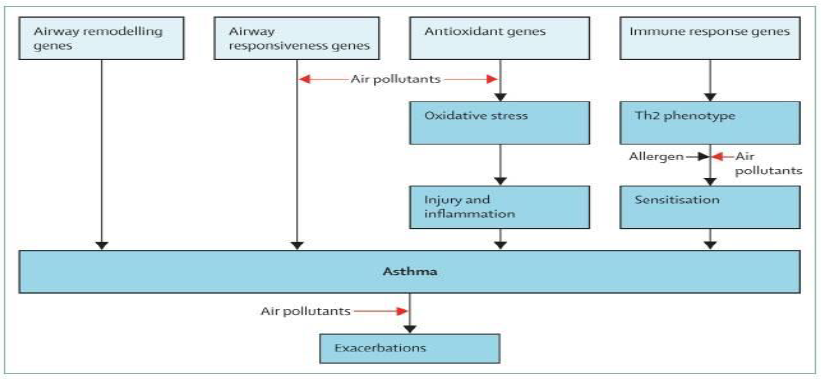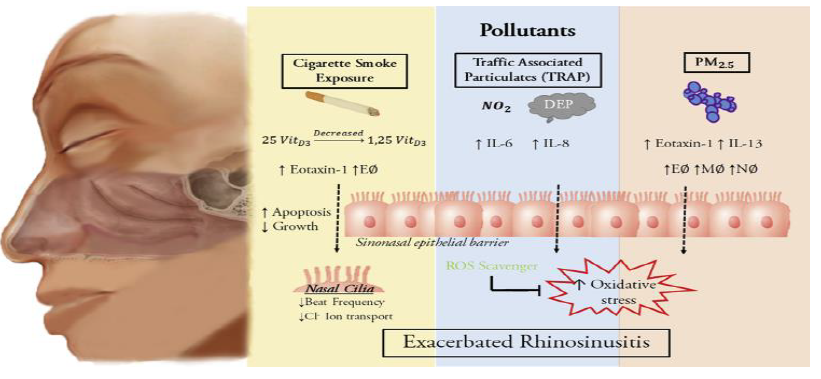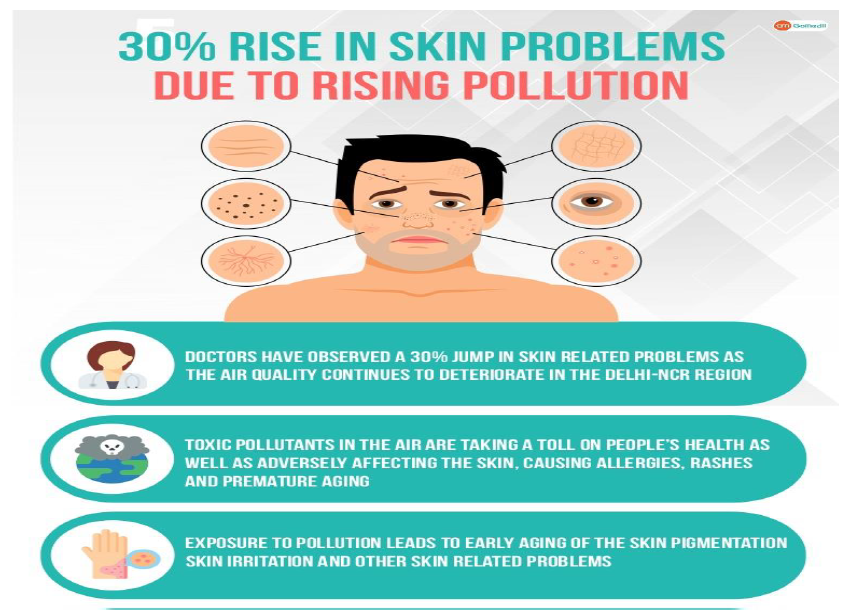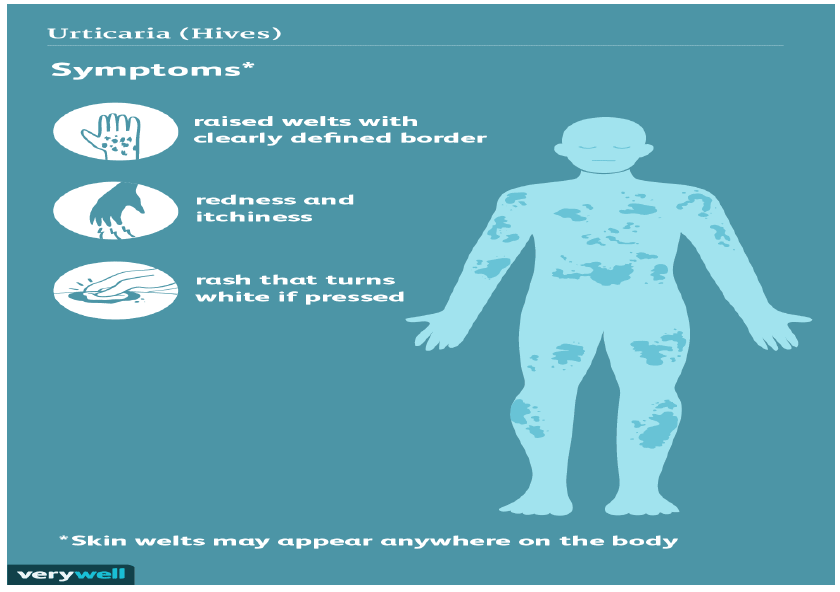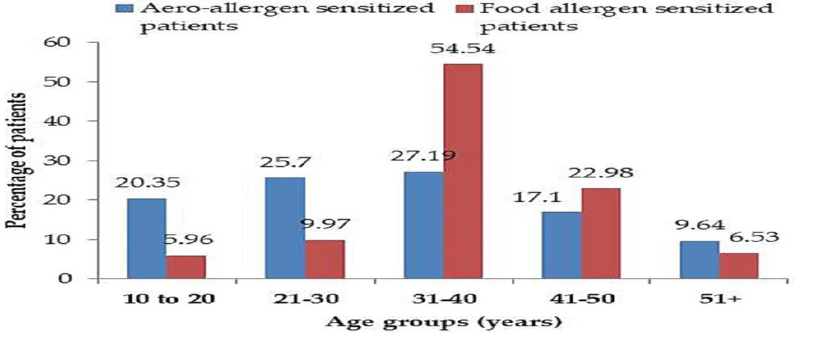Air Pollution and Boosting Skin and Aero-Allergies
Article Information
Linta Khalid1*, SamreenRiaz2
1Department of Microbiology and Molecular Genetics (MMG), University of Punjab, Lahore, Pakistan
2Assistant Professor, Department of Microbiology and Molecular Genetics, University of Punjab, Lahore, Pakistan
*Corresponding author: Linta Khalid, Department of Microbiology and Molecular Genetics (MMG), University of Punjab, Lahore, Pakistan
Received: 29 May 2021; Accepted: 11 June 2021; Published: 13 September 2021
Citation: Linta Khalid, SamreenRiaz. Air Pollution and Boosting Skin and Aero-Allergies. Archives of Microbiology and Immunology 5 (2021): 363-372.
View / Download Pdf Share at FacebookAbstract
The frequency of hypersensitive illnesses in most industrialized nations has expanded. Albeit the specific components behind this fast expansion in pervasiveness stay dubious, an assortment of air pollutants have been standing out as one causative factor. Epidemiological and toxicological exploration recommends a causative connection between air pollutants and the expanded occurrence of asthma, hypersensitive rhinitis, hives and other skin allergies problems. These incorporate ozone, nitrogen dioxide and, particularly particulate matter, created by traffic-related and modern exercises. Solid epidemiological proof backings a connection between air pollution and the intensification of asthma, aero-allergies and skin allergies. Most of the allergies mainly skin are untreatable except that they can be suppressed by steroids and vaccination (a long term treatment).
Keywords
Air Pollutants; Asthma; Rhinitis; Sinuses; Skin Allergies; Aero-Pollutants
Air Pollutants articles; Asthma articles; Rhinitis articles; Sinuses articles; Skin Allergies articles; Aero-Pollutants articles
Article Details
1. Introduction
The worldwide expansion in the pervasiveness of hypersensitive illnesses is of extraordinary concern . Among the various known reasons for unfavorably susceptible sicknesses, metropolitan air contamination has been standing out as a significant ecological and extraneous etiologic specialist[i]. This incorporates vaporous materials like ozone (O3) and nitrogen dioxide (NO2), just as particulate matter (PM), which is created via vehicle traffic and industry. Solid epidemiological proof backings a connection between air contamination and the fuel of asthma and other unfavorably susceptible infections like sinuses, rhinitis, hives ,Eczema; undoubtedly, ongoing examinations have recommended that poisons assume a pivotal part in the improvement of these hypersensitive problems. Exploratory examinations have clarified the cell and sub-atomic occasions that clarify how these contaminations actuate unfriendly impacts in the respiratory framework . Moreover, late quality ecological methodologies have been explaining the systems by which a host has expanded weakness to air contaminations. This audit will portray late advances in our comprehension of the effect of air contaminations on hypersensitive illnesses, with exceptional reference to the unfavorable impact of particles.
2. Air Pollutants and Allergic Disorders: Epidemiological Studies
Expanding proof backings a connection between air contaminations and general respiratory indications as well as pneumonic capacity. Dockery found a relationship between air contamination and mortality in six US urban areas. Their planned partner investigation of 8,111 grown-ups showed that fine-particulate air contamination, or a more intricate contamination blend related with fine particulate matter, added to overabundance mortality. This affiliation was additionally reinforced by reports that diminished openness to PM10 brought about a constricted age-related decrease in lung work following 11 years Openness to O3 at focuses found in encompassing air is related with a decrease in lung capacity and enlistment of respiratory side effects including hack and windedness. Significantly, people seem to vary as to weakness to O3. NO2 focuses in encompassing air are additionally apparently connected with hack, wheezing, and windedness in youngsters. Most often, chronic rhinitis is caused by allergies (also known as hay fever) [1], but there are several other causes unrelated to allergies, including: medications. irritants in the air. Gauderman tracked down that metropolitan air contamination may have enduring unfavorable consequences for lung advancement in youngsters matured 10-18 years, as estimated by constrained expiratory volume in one second (FEV1). Ackermann-Liebrich et al. tracked down that drawn out openness to air toxins, for example, NO2 and PM10 in Switzerland was related with decreased lung working in grown-ups. Private traffic-related air contamination openness is allegedly connected with decreased expiratory streams in younger students, and youngsters moving to zones with varying air contamination levels experience changes in lung work that reflected changes in PM openness. Along these lines, air contamination, particularly contamination related with traffic load, impressively affects respiratory-related bleakness and mortality. Numerous epidemiological examinations have zeroed in on the connection between air contamination and unfavorably susceptible illnesses, particularly asthma.
3. Mechanism of Allergic Reactions
Sensitivity alludes to unusual responses of the invulnerable framework to in any case innocuous substances. Regularly, the invulnerable framework raises insusceptible reaction to shield the body from unfamiliar trespassers, like microscopic organisms or infections, yet doesn't respond to non-irresistible ecological antigens. In individuals with hypersensitivities, notwithstanding, the invulnerable framework additionally responds to these substances, creating unfavorably susceptible responses. Such substances, called allergens, can emerge out of the patient's common habitat, food sources, prescriptions, latex items, or creepy crawly chomps [2].
Most sensitivities are intervened by a class of immunizer called immunoglobulin E, IgE. IgE is created when the body is first presented to an allergen. Creation of IgE is actuated by a subtype of T-lymphocytes, known as type 2 assistant T-cells, TH2. IgE atoms at that point tie to their receptors on the outside of pole cells and basophils. The main openness is typically asymptomatic, however the body is presently sharpened. Upon reexposure to a similar antigen, the antigen ties to adjoining IgE particles, uniting their receptors, setting off a flagging course that initiates the arrival of histamine and other fiery synthetic substances. These synthetics cause enlargement and expanded porousness of veins, bodily fluid discharge, incitement of tangible nerves, smooth muscle fits, and are answerable for unfavorably susceptible manifestations, which can go from gentle to serious. Gentle manifestations as a rule comprise of watery eyes, runny nose, wheezing and a gentle rash; while serious responses may incorporate expanding, hives, trouble breathing because of bronchospasm, and stomach related issues because of expanded gastrointestinal motility. When delivered foundationally, these synthetic substances can cause broad vasodilation and smooth muscle fits which may prompt hypersensitivity, a hazardous condition where pulse drops and aviation routes limited to a risky level. The responses are quick, promptly after contact with the allergen. There is additionally a late stage reaction, because of resulting tissue penetration with eosinophils and other incendiary cells.
Individuals who are sharpened to a particular allergen may likewise respond to different substances that contain comparative antigens. This is called cross-reactivity. For instance, individuals who are adversely affected by birch dust may likewise have responses to specific foods grown from the ground like apples or potatoes, utilization of which can cause tingling and expanding of the lips and oral depression. Both hereditary and natural variables add to the advancement of unfavorably susceptible sicknesses. Hypersensitivities will in general spat families. What is acquired is the helplessness to hypersensitive responses, because of anomalies in the cosmetics of the safe framework. Sensitivity alludes to unusual responses of the invulnerable framework to in any case innocuous substances. Regularly, the invulnerable framework raises insusceptible reaction to shield the body from unfamiliar trespassers, like microscopic organisms or infections, yet doesn't respond to non-irresistible ecological antigens. In individuals with hypersensitivities, notwithstanding, the invulnerable framework additionally responds to these substances, creating unfavorably susceptible responses. Such substances, called allergens, can emerge out of the patient's common habitat, food sources, prescriptions, latex items, or creepy crawly chomps [3].
4. Pollutants Impact on Asthma Patients
A generous group of exploration on the impacts of air contamination on asthma has been distributed in the previous 5 years, adding to the assemblage of information that has aggregated more than a very long while. As of now, momentary openings to ozone, nitrogen dioxide, sulfur dioxide, PM2.5, and TRAP is thought to build the danger of intensifications of asthma indications [4]. Expanding measures of proof additionally recommend that drawn out openings to air contamination, particularly TRAP and its proxy, nitrogen dioxide, can add to new-beginning asthma in the two youngsters and grown-ups. Considerably more about the instruments that are engaged with intensifications incited by contamination and beginning of asthma should be seen, however oxidative pressure and resistant dysregulation are most likely both included [5]. Little youngsters with asthma, particularly those experiencing childhood in financially distraught areas, are at expanded danger of unfriendly impacts from openings to air contamination. Disentangling what segments of the traffic contamination blend are answerable for asthma intensifications and beginning is a significant test. Improved air quality to forestall intensifications and new instances of asthma will require solid administrative endeavors to move economies in both created and non-industrial nations from ignition of petroleum derivatives for transportation and energy creation; this methodology is additionally expected to alleviate environmental change [6].
5. Pollutants Aggravates Sensitivity Rhinitis and Sinuses
Essentially everybody has encountered sniffling, a running nose or bothersome eyes subsequent to cleaning their home. The condition is regularly brought about by openness to family tidies that have gotten airborne. This equivalent residue can considerably trigger asthma side effects in certain individuals. Aeroallergens can even connect with other hurtful air contamination to deteriorate different respiratory sicknesses.People who get rhinitis - an aroused or blocked nose - from colds or sensitivities may feel a lot of more regrettable on the off chance that they're presented to significant degrees of air contamination, a new report proposes. Rhinitis ordinarily includes a mix of clog, wheezing, nasal bothering and at times a decreased feeling of smell, and it influences up to half of the total populace, the investigation group writes in Journal of Allergy and Clinical Immunology. "Breathing contaminated air will cause aggravation and oxidative weight on the respiratory lot," said lead study creator Emilie Burte of INSERM in Villejuif, France. "That likely will build the recurrence or seriousness of rhinitis side effects," Burte said by email.
Despite the fact that rhinitis is particularly normal among individuals with asthma - a condition that is exasperated via air contamination - exploration to date hasn't offered a reasonable image of what air quality means for the seriousness of rhinitis. For the ebb and flow study, scientists analyzed information on air contamination openness and side effect seriousness for around 1,400 individuals with rhinitis in 17 European urban areas. Two sorts of poisons specifically were related with more awful rhinitis side effects: nitrogen oxide, a side-effect of non-renewable energy source burning that adds to brown haze; thus called PM 2.5, a combination of strong particles and fluid beads less than 2.5 micrometers in distance across that can incorporate residue, earth, ash and smoke.
Individuals in urban areas with the most elevated levels of PM 2.5, or fine particulate matter, announced the most extreme rhinitis indications. Each increment of 5 micrograms for every cubic meter of air (mcg/m3) in groupings of fine particulate matter was related with a 17% higher possibility that individuals with rhinitis would encounter extreme indications, the examination found. Fine particulate matter was related with more terrible clog, nasal disturbance and sniffling. Nitrogen dioxide was likewise attached to more serious rhinitis, especially for side effects like nasal release and blockage. The poisons intensifying rhinitis in the investigation have for some time been connected to traffic vapor, with more awful air quality around significant streets in urban communities around the planet [7]. While the investigation wasn't intended to demonstrate whether air contamination causes rhinitis or exacerbates manifestations, it's conceivable that every sort of foreign substance noticeable all around does its own kind of harm in the respiratory framework, Burte said. Individuals inclined to colds and sensitivities can't do a lot to keep contamination from aggravating rhinitis, beside remaining inside, said Yaguang Wei, an ecological wellbeing scientist at Harvard University in Boston who wasn't associated with the examination [8]. Individuals can focus on air quality alarms for their city or local area and plan to remain inside or possibly maintain a strategic distance from enthusiastic movement outside during top contamination times. "For indoor air contamination, air purifiers can clean indoor air and secure your family, particularly for youngsters and the old," Wei said by email. Individuals can likewise do their part to decrease traffic vapor.
Figure 2: Cigarette smoke exposure (yellow) results in decreased conversion of 25 vitamin D3 to activated 1, 25 vitamin D3. The presence of smoke exposure results in increased Eotaxin-1 and eosinophil accumulation as well as increased apoptosis and reduced regeneration of the sinonasal epithelial barrier. Cigarette smoke also directly affects nasal cilia by reducing beat frequency and ion transport. Traffic associated particulates (blue), such as diesel exhaust particles (DEP), cause increased IL-6 and IL-8 activity and have likewise been shown to increase epithelial barrier permeability. The resulting effect is increased oxidative stress which can be combated with ROS (reactive oxygen species) scavengers. PM2.5 (particular matter < 2.5 microns in size, red) have been shown to increase immune cells response (Eø = eosinophils, Mø = macrophages, Nø = neutrophils). This likewise results in increased cellular oxidative stress. The cumulative effect from each pollutant is the exacerbation of rhinosinusitis [9].
6. Facts and Figures in Pakistan
In Pakistan, Women had a 2.2 times higher burden of this condition than males 18(28.8%) verses 21(12.9%) respectively (p = 0.011). Workwise the prevalence of allergic rhinitis was highest among doctors 10 (30%), followed by nurses 8 (20%), technicians 12(15.6%) and pharmacists 3 (15%). However this workwise difference was not statistically significant. The most common symptom in the participants with allergic rhinitis was sneezing followed by itchy and watery eyes, runny or blocked nose.Our examination proposes a commonness of hypersensitive rhinitis in 19% of medical services laborers. Female medical services laborers were 2.2 occasions more inclined to this condition. Hypersensitive rhinitis is a vexatious condition and adversely affects work profitability of medical care laborers. Executing preventive measures and focusing on workplace can help in controlling hypersensitive rhinitis and its effect on work. It features the requirement for expanding mindfulness with the goal that a commonsense treatment can be offered for this condition. It gives a premise to institutional approaches for a better air in our establishments [10].
7. Can Air Pollution Cause Skin Allergies:
Figure 3: Exposure of the skin to air pollutants has been related with skin maturing and provocative or unfavorably susceptible skin conditions [11], for example, atopic dermatitis, dermatitis, psoriasis or skin break out, while skin malignancy is among the most genuine impactsFor certain individuals, an expansion in airborne poisons like PM2. 5, VOCs, ozone (O3), and nitrogen dioxide (NO2) can trigger a hives flare-up. An investigation led in Windsor, Canada, discovered that trauma center visits for hives expanded according to transient spikes in surrounding air contamination.Significant air toxins with impacts on the skin incorporate the sun based UVR, PAHs, VOCs, NOx, PM, O3, and tobacco smoke. Impressive impacts intervened via air toxins on the human skin may add to skin maturing, atopic dermatitis, skin malignancy, psoriasis, and skin inflammation [12].
Figure 4: Oxides have been related with expanded commonness of atopic dermatitis just as intensifications of the infection in youngsters. VOCs, with the presence of daylight and NOx, cause the development of photochemical oxidant items - primarily O3-at ground level, additionally called summer photochemical brown haze. Openness to O3 has been related with urticaria, skin inflammation, contact dermatitis, and other vague emissions. Openness to PM adds to extraneous skin maturing (wrinkles, pigmented macules or spots). Cigarette smoking has been related with skin maturing (wrinkles, skin dryness, skin dyschromias), and the blend of smoking and sun openness may synergistically affect skin maturing. Besides, it has been related with skin disease (SCC, BCC), psoriasis and skin inflammation vulgaris.
Family background of unfavorably susceptible infections is quite possibly the most inclining factors in the improvement of allergen refinements. Another examination likewise revealed a higher commonness of sensitivity among individuals having family ancestry (76.3%). Hereditary factors alongside natural elements lead to atopy In this way, it is proposed that people with family background of atopy should dodge openness to such allergens as they are more helpless to create excessive touchiness responses. Measurable examination additionally recommended critical contrast in the predominance of allergen refinement among atopic and non-atopic people by chi square test (p < 0.05). Then again, poisons (i.e., O3, NO2, and SO2) and dispersing particulates (mists and ash) in the lower atmosphere lessen the impacts of more limited frequency UVR and critical decreases in UV irradiance have been seen in dirtied, metropolitan zones [13].
7.1 Treating environmental allergies
For aero allergens, such as pollen, dust, and mold spores, simple treatments include:
- throat cachou with soothing ingredients, such as menthol, honey, or ginger
- shower after visiting outside home.
- exercise for a few minutes to help reduce nasal congestion and suppress allergic reaction [14].
7.2 Treating allergies on the skin
For allergic reactions that cause skin symptoms, including those associated with allergens found in animal saliva, poisonous plants, drugs, chemicals and metals, additional treatment options include:
- Topical corticosteroid creams or tablets. Corticosteroids contain steroids that reduce inflammation and itching. light forms of these creams can be found online, and a doctor can prescribe stronger versions.
- Moisturizing creams. creams with soothing ingredients can treat skin reactions.
- Bite or sting medication. Medication targeted to supress allergic reactions to insect bites or stings had a similar effect to other allergy medications.
- Ice pack. Using an ice pack wraped in cloth to the area for 10- to 15-min intervals can suppress inflammation.
8. Discussion
Pakistan is an agro-mechanical agricultural nation confronting basic environmental difficulties because of a few anthropogenic exercises. Air nature of Pakistan is a disturbing danger to populace wellbeing and the circumstance turns out to be most noticeably awful with ascend in the dust tallies that lead to high commonness of allergen refinements among individuals In this examination, allergen sharpened patients visiting the Allergy Center, NIH, Islamabad showed an altogether higher commonness of refinement to air allergens when contrasted with food allergens as demonstrated by the chi square test(p<0.05). There was 1.5% cover seeamong two kinds of allergen refinements among all out patients.Accordingly, dominant part of the patients executed affectability response towards air allergens and another investigation additionally revealed the higher pervasiveness of air allergen sharpened patients (97.7%) when contrasted with food-allergen sharpened (2.30%) patients.
8.1 Solution and future consideration
In Islamabad, Allergy center has been made for the vaccination of allergies but these are hard and fast solutions and need long term treatments. Although there are anti-histamines present in market for temporary relief but till date all the doctors and microbiologist suggest care and precuations about allergies. For airborne allergens, like dust, residue, and shape spores, extra treatment alternatives include: throat tablets with relieving fixings, like menthol, nectar, or ginger. shower and wash all apparel in the wake of being presented to an allergen. practice for a couple of moments to help lessen nasal clog.
9. Conclusion
This investigation was meant to feature the latest things of unfavorably susceptible patients in Pakistan because of its thought as disregarded infections. This investigation illuminated distinctive hypersensitivity situations among individuals visiting one of the significant public sensitivity habitats in Pakistan. It featured that inside a year, an enormous number (n=50,550) of people with assorted socioeconomics going to the hypersensitivity place were sharpened to allergens and experienced distinctive unfavorably susceptible sicknesses that addressed weight on sensitivity community [16]. Along these lines, this condition requests setting of more hypersensitivity places in the country [17]. There are exceptionally restricted investigations in Pakistan that welcome this reliable issue on cutting edge which ought to be tended to expeditiously at general wellbeing level. There is likewise need to improve the indoor and outside air quality which is assuming a significant part in worsening the hypersensitive illnesses upon openness [18]. While it is additionally uncovered here that nearby in-house entire allergen and residue removes are utilized regularly to analyze and treat the refinement.
References
- What Causes Chronic Rhinitis?. Healthline (2019).
- https://www.youtube.com/watch?v=llZFx8n-WCQ
- https://youtu.be/llZFx8n-WCQ
- Suh-Young Lee, Yoon-Seok Chang, Sang-Heon Cho. Allergic diseases and air pollution. Asia Pac Allergy 3 (2013): 145-154.
- Modig L, Torén K, Janson C, et al. Vehicle exhaust outside the home and onset of asthma among adults. Eur Respir J 33 (2009): 1261-1267.
- Gowers AM, Cullinan P, Ayres JG, et al. Does outdoor air pollution induce new cases of asthma? Biological plausibility and evidence; a review. Respirology 17 (2012): 887-898.
- Mishra V. Effect of indoor air pollution from biomass combustion on prevalence of asthma in the elderly. Environ Health Perspect 111 (2003): 71-78.
- Air pollution may aggravate nasal suffering with colds and seasonal allergies. Healthcare & Pharma (2020).
- Kampa M, Castanas E. Human health effects of air pollution. Environ Pollut 151 (2008): 362-367.
- ly/31W84az Journal of Allergy & Clinical Immunology, online January 23, 2020.
- https://www.google.com/url?sa=i&url=https%3A%2F%2Fwww.slideshare.net%2Fvipulsrivastava33%2Fwith-rising-pollution-there-is-a-30-rise-in-skin-problems-as-well-anju-bisht-nov-21-2019-news-research&psig=AOvVaw0aVLduUSPYTTmdvLUT1eWE&ust=1616855466443000&source=images&cd=vfe&ved=0CAMQjB1qFwoTCJCj7I6Wzu8CFQAAAAAdAAAAABAD
- Kathrin Reinmuth-Selzle, Christopher J Kampf, Kurt Lucas, et al. Air Pollution and Climate Change Effects on Allergies in the Anthropocene: Abundance, Interaction, and Modification of Allergens and Adjuvants. Environ. Sci. Technol 51 (2017): 4119-4141.
- 4 Skin Problems Associated With Air Pollution. AWAIR (2019).
- Boyd A S, Shyr Y, King L E. Basal cell carcinoma in young women: an evaluation of the association of tanning bed use and smoking. J. Am. Acad. Dermatol 46 (2002): 706-709.
- https://www.medicalnewstoday.com/articles/321500#:~:text=Most%20minor%20allergy%20symptoms%20can,option%20for%20chronic%20allergy%20symptoms.
- Climate and temperature of Pakistan (2018).
- London NR, Tharakan A, Rule AM, et al. Air-pollutant mediated disruption of sinonasal epithelial cell barrier function is reversed by activation of the Nrf2 pathway. J Allergy Clin Immunol 138 (2016): 1736-1738.
- Zhao R, Guo Z, Zhang R. Nasal epithelial barrier disruption by particulate matter ≤2.5 μm via tight junction protein degradation. J Appl Toxicol 38 (2018): 678-687.
- Saxon A, Diaz-Sanchez D. Air pollution and allergy: you are what you breathe. Nat Immunol 6 (2005): 223-226.
- Valenta R, Linhart B, Swoboda I, et al. Recombinant allergens for allergen-specific immunotherapy: 10 years anniversary of immunotherapy with recombinant allergens. Allergy 6 (2011): 775-783.

